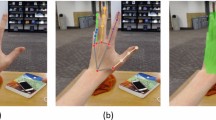Abstract
Large interactive surfaces enable novel forms of interaction for their users, particularly in terms of collaborative interaction. During longer interactions, the ergonomic factors of interaction systems have to be taken into consideration. Using the full interaction space may require considerable motion of the arms and upper body over a prolonged period of time, potentially causing fatigue. In this work, we present Curved, a large-surface interaction device, whose shape is designed based on the natural movement of an outstretched arm. It is able to track one or two hands above or on its surface by using 32 capacitive proximity sensors. Supporting both touch and mid-air interaction can enable more versatile modes of use. We use image processing methods for tracking the user’s hands and classify gestures based on their motion. Virtual reality is a potential use case for such interaction systems and was chosen for our demonstration application. We conducted a study with ten users to test the gesture tracking performance, as well as user experience and user preference for the adjustable system parameters.












Similar content being viewed by others
References
Annett M, Grossman T, Wigdor D, Fitzmaurice G (2011) Medusa: a proximity-aware multi-touch tabletop. In: Proceedings UIST. ACM, pp 337–346
Bachynskyi M, Oulasvirta A, Palmas G, Weinkauf T (2014) Is motion capture-based biomechanical simulation valid for HCI studies?: study and implications. In: Proceedings of the 32nd annual ACM conference on human factors in computing systems. ACM, pp 3215–3224
Bachynskyi M, Palmas G, Oulasvirta A, Steimle J, Weinkauf T (2015) Performance and ergonomics of touch surfaces: a comparative study using biomechanical simulation
Benko H, Jota R, Wilson A (2012) Miragetable: freehand interaction on a projected augmented reality tabletop. In: Proceedings CHI. ACM, pp 199–208
Braun A, Hamisu P (2011) Designing a multi-purpose capacitive proximity sensing input device. In: Proceedings PETRA, p. Article No. 15. https://doi.org/10.1145/2141622.2141641. http://dl.acm.org/citation.cfm?doid=2141622.2141641
Braun A, Krepp S, Kuijper A (2015) Acoustic tracking of hand activities on surfaces. In: Proceedings iWOAR, WOAR ’15. ACM, New York, pp 9:1–9:5. https://doi.org/10.1145/2790044.2790052. http://doi.acm.org/10.1145/2790044.2790052
Braun A, Wichert R, Kuijper A, Fellner DW (2015) Capacitive proximity sensing in smart environments. J Ambient Intell Smart Environ 7(4):1–28. https://doi.org/10.3233/AIS-150324
Braun A, Zander-Walz S, Krepp S, Rus S, Wichert R, Kuijper A (2016) CapTap: combining capacitive gesture recognition and acoustic touch detection. In: Proceedings of the 3rd international workshop on sensor-based activity recognition and interaction. ACM, p 6
Braun A, Zander-Walz S, Majewski M, Kuijper A (2017) Curved—free-form interaction using capacitive proximity sensors. Procedia Comput Sci 109:59–66. https://doi.org/10.1016/j.procs.2017.05.295 https://doi.org/10.1016/j.procs.2017.05.295. http://www.sciencedirect.com/science/article/pii/S1877050917309523
Earnshaw RA (2014) Virtual reality systems. Academic, New York
Faulkner L (2003) Beyond the five-user assumption: benefits of increased sample sizes in usability testing. Behav Res Methods 35(3):379–383
Grosse-Puppendahl T, Berghoefer Y, Braun A, Wimmer R, Kuijper A (2013) OpenCapSense: a rapid prototyping toolkit for pervasive interaction using capacitive sensing. In: Proceedings PerCom, pp 152–159. https://doi.org/10.1109/PerCom.2013.6526726
Grosse-Puppendahl T, Braun A, Kamieth F, Kuijper A (2013) Swiss-cheese extended: an object recognition method for ubiquitous interfaces based on capacitive proximity sensing. In: Proceedings of the 2013 ACM annual conference on human factors in computing systems. ACM, pp 1401–1410
Grossman T, Wigdor D, Balakrishnan R (2004) Multi-finger gestural interaction with 3D volumetric displays. In: Proceedings UIST. ACM, pp 61–70. http://dl.acm.org/citation.cfm?id=1029644
Hu MK (1962) Visual pattern recognition by moment invariants. IRE Trans Inf Theory 8(2):179–187
Le Goc M, Taylor S, Izadi S, Keskin C et al (2014) A low-cost transparent electric field sensor for 3D interaction on mobile devices. In: Proceedings CHI, pp 3167–3170
Ma D, Fan X, Gausemeier J, Grafe M (2011) Virtual reality & augmented reality in industry, Springer, Berlin. http://www.springerlink.com/index/10.1007/978-3-642-17376-9
Rekimoto J (2002) SmartSkin: an infrastructure for freehand manipulation on interactive surfaces. In: Proceedings CHI. ACM, pp 113–120
Ren Z, Meng J, Yuan J, Zhang Z (2011) Robust hand gesture recognition with kinect sensor. In: Multimedia. ACM Press, New York, p 759. https://doi.org/10.1145/2072298.2072443. http://dl.acm.org/citation.cfm?id=2072298.2072443
Roudaut A, Pohl H, Baudisch P (2011) Touch input on curved surfaces. In: Proceedings CHI. ACM, pp 1011–1020
Samsung Inc. (2014) CES 2014: Samsung unveils first curved ultra high definition (UHD) TVs
Schlömer T, Poppinga B, Henze N, Boll S (2008) Gesture recognition with a Wii controller. In: Proceedings of the 2nd international conference on tangible and embedded interaction. ACM, pp 11–14
Smith J, White T, Dodge C, Paradiso J, Gershenfeld N, Allport D (1998) Electric field sensing for graphical interfaces. IEEE Comput Graph Appl 18(3):54–60
University of Groningen (2011) Reality touch theatre. http://www.rug.nl/news/2011/01/touchscreen1?lang=en
Weichert F, Bachmann D, Rudak B, Fisseler D (2013) Analysis of the accuracy and robustness of the leap motion controller. Sensors 13(5):6380–6393
Wimmer R, Baudisch P (2011) Modular and deformable touch-sensitive surfaces based on time domain reflectometry. In: Proceedings UIST. ACM, pp 517–526
Wimmer R, Kranz M, Boring S, Schmidt A (2007) Captable and capshelf-unobtrusive activity recognition using networked capacitive sensors. In: INSS. IEEE, pp 85–88
Acknowledgments
We would like to thank Stefan Krepp, Steeven Zeiss, Joachim Loge, and Maxim Djakow for their input to the hardware and software development, as well as our study participants for their valuable comments.
Funding
This work was partially supported by EC Grant Agreement No. 610840.
Author information
Authors and Affiliations
Corresponding author
Rights and permissions
About this article
Cite this article
Braun, A., Zander-Walz, S., Majewski, M. et al. Investigating large curved interaction devices. Pers Ubiquit Comput 23, 739–748 (2019). https://doi.org/10.1007/s00779-018-1109-6
Received:
Accepted:
Published:
Issue Date:
DOI: https://doi.org/10.1007/s00779-018-1109-6




